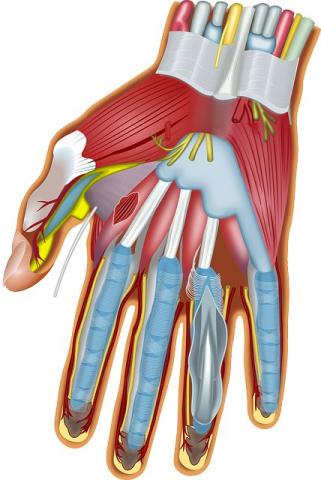Anatomy of the Hand
 It is the anatomy of the hand to which we owe this great range of movement and precision. To fully appreciate the wonder of the hand, it is important to understand its complex structures and mechanics.
It is the anatomy of the hand to which we owe this great range of movement and precision. To fully appreciate the wonder of the hand, it is important to understand its complex structures and mechanics.
Bones
The human hand is made from 27 different bones that all work together to make the many motions of the hand possible. Each hand has 14 finger bones or phalanges, 5 metacarpal bones, and 8 carpal bones.
Aside from the thumb, each finger has three bones and three joints. All three of the joints in the four fingers move in one direction. The thumb only has two bones, but it has the ability to rotate, which allows it to go in opposition of the fingers.
The five metacarpal bones are the ones that you can see from the back of your hand. They go from the base of your fingers and extend back to the second row of carpal bones. The metacarpus is also the region where the thumb gains its ability for rotation. With the metacarpal that extends to the thumb and the proximal phalanx, you have the carpometacarpal joint, giving this digit its great freedom of motion.
The carpal bones come in two rows. You have a first row of four that are closer to the forearm and a second row of four that is closer to the carpus. The two rows of carpal bones and the joints of the carpus are important for the movement of the hand and the ability to extend and flex near the wrist.
Muscles
There are more than 30 muscles that contribute to the strength and motion of the hand. For hand strength and motion, the forearm, wrist, and hand work together as one functional unit.
While the long forearm muscles only connect to the hands through the extensor and flexor tendons, they are responsible for much of the hand’s strength and its ability to extend.
In the hand itself, you have the short hand muscles for controlling the fingers, the thenar eminence for controlling the thumb and allowing opposition, the hypothenar eminence for controlling the little finger, and the lumbricals.
Nerves
You have three nerves that are responsible for controlling the muscles of the hand and the sense of touch. These are the radial nerve, the median nerve, and the ulnar nerve.
- The radial nerve is strictly for the sense of touch. It does not control any of the muscles of the hand. This nerve transmits sensory signals from the back of the hand, fingers, and thumb.
- The median nerve controls some of the lumbricals and the thenar eminence muscles. In addition to that, it is also responsible for sensing stimuli to the palm and some parts of the fingers.
- The ulnar nerve controls the rest of the lumbricals, the hypothenar eminence, and the muscles in the metacarpus. It is also responsible for sensory functions in certain parts of the fingers.
The Carpal Tunnel
The nerves, blood vessels and muscle tendons connect to the hand through a passageway. This passageway is on the palmar side of the wrist and it is called the carpal tunnel. It is made from the carpal bones and connective tissue. From the motion in the area of this passageway, it is susceptible to inflammation and injury, leading to a condition commonly referred to as carpal tunnel syndrome.

